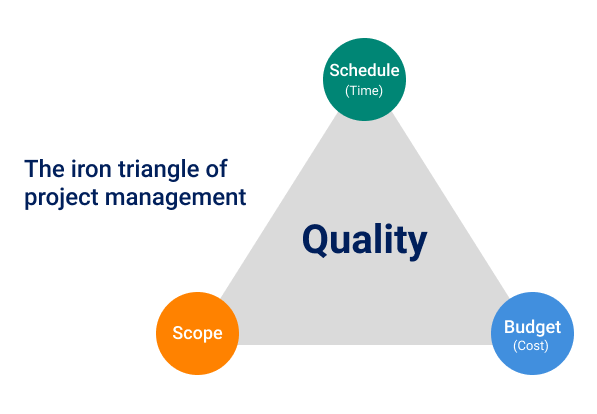What is the Iron Triangle of Project Management?

Last Updated March 8, 2024
If you’ve worked in project management, you’ve likely encountered the iron triangle – even if you didn’t acknowledge it in such an official capacity. The iron triangle, also known as the project triangle, flexibility matrix or the triple constraints of project management, models the constraints that project managers work within on every project they oversee.
The Triple Constraints of Project Management in the Iron Triangle
Project managers work within three project constraints: budget, scope and schedule. Schedule (or time) is at the top of the model (shaped like a triangle). Scope is on the left of the triangle and budget (or cost) is on the right. Depending on the project or who is involved, each of these project constraints could be the most important to the end-user. Quality resides in the middle of the project triangle, and effective project managers must balance the ebb and flow of tradeoffs within these three constraints in order to achieve success.

This longstanding model provides a dynamic way to approach priorities on a project and supports describing items of value in a project team (particularly since each team member likely values something different), according to Villanova’s Leading Agile Teams course.
Let’s examine each constraint and learn how to drive successful projects with a commanding understanding of the iron triangle. Project managers must balance how they adjust constraints to achieve the desired outcome of the project, keeping in mind that too much adjustment can impact the other two project constraints.
Cost
Cost is the financial constraint of the iron triangle, also referred to as the budget. Project costs can include a variety of elements, including resources – both materials and people – as well as any external costs that influence a project.
In some cases, costs are fixed and cannot flex; in others, costs are variable and can be adjusted to meet needs.
For example, if a piece of the project requires using contract workers and the work takes longer than anticipated, the cost may increase. A client will almost never have an unlimited budget (though at first they may say they do), which
makes this constraint fairly fixed.
To harness project costs, project managers must establish a budget and a baseline upfront, using a combination of items:
- Historic data from similar projects to provide a comparison
- Establishing resources costs at a unit level, to help predict any changes
- The lowest and highest ranges anticipated
- Vendor bid averages, if applicable
Scope
In the project triangle, scope comprises the tasks necessary to achieve the project’s goals. Controlling project scope is
especially critical, as adjustments to scope almost guarantee an impact to cost and time.
For example, if the original request requires 10 hours of work but a stakeholder requests another addition that represents another 10 hours, it’s likely that end project costs and time will increase. Often, it is this balance
of stakeholder requests that is critical to manage, particularly if stakeholders come and go into the project.
Keep in mind, the amount of time each task will take is critical to managing project scope.
Time
The time constraint of the iron triangle represents the project’s scheduled completion. Managing time is closely related to managing tasks, as the overall timeline is broken down by individual tasks and their anticipated timing. To manage time, project managers should identify tasks that must be done in sequential order and which are interdependent.
Time management, according to A Guide to the Project Management Body of Knowledge (PMBOK® Guide) – Seventh Edition, includes:
- Planning the schedule
- Identifying and defining all activities that must occur throughout the project
- Establishing the correct sequence
- Estimating all the resources required; if resources are too scarce or otherwise occupied, the timeline can be affected
- Estimating the length of time required for each activity
- Tracking how closely the project is following the initial plan throughout the work
Sometimes, the timeline on a project is concrete, adhering to a specific milestone or data. In other projects, the timeline can be more flexible. But just as budgets are seldom unlimited, clients seldom accept any delivery time.
Applying the Iron Triangle to Project Management
The iron triangle is a give-and-take balance the project manager needs to master by manipulating variables that can change in order to allow for those that cannot. Together, balancing these three project constraints can help determine the quality of the overall project. For example, if a project must be complete by a specific deadline, the scope may need to be reduced, or costs increased to accommodate additional resources or overtime. Or if a project cannot exceed a budget, the project manager may need to extend time to reduce overtime used.
These factors don’t work in isolation. According to an article by the Project Management Institute titled, “Beyond the Iron Triangle,” project managers should consider softer factors like personal motivation and social expectations (like meeting attendance and analytic space). These internal factors can influence projects just as much as the three constraints of the project triangle.
Overall, project managers should have clear context and understanding of the project constraints to allow decisions about the iron triangle components to be made in an informed way that projects the quality of the outcome and meets the specific quality goals of each unique project.
PMBOK is a registered mark of the Project Management Institute, Inc.




